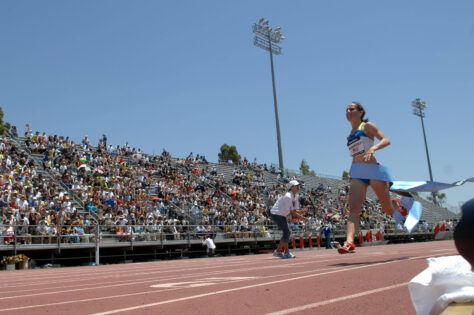It is one of sport’s most paradoxical realities! The very country that produces the lion’s share of global track and field talent may be the hardest place in the world for an athlete to survive. While American sprinters, hurdlers, and jumpers regularly dominate podiums, many of them do so while navigating a system that barely sustains their careers. According to one veteran coach, the pipeline that drives world-class performances is riddled with financial gaps, structural neglect, and misplaced priorities. And the situation, he warns, is more dire than it appears.
At the center of this growing unrest is Coach Rob, a respected figure within the sport who has spent years watching athletes attempt to thrive in a model that seems allergic to stability. Speaking plainly, he noted that the system forces American athletes to rely on medals, marketing, and miracles. “You better hope that you get a medal at the Worlds or the Olympics,” he said. “And even if you do, you had better be a brand. Just running fast ain’t good enough.” He pointed to Daniel Roberts as one example, an Olympic silver medalist who was dropped by his sponsor soon after his achievement. The issue, Coach Rob argued, is not about one contract or one athlete, but rather a structure that offers no real safety net.
This is why, Coach Rob believes, the United States has quietly become the training ground of the world, not because its system is generous, but because international programs are even more fragile. “Go out there and talk to the track and field athletes,” he added in his YouTube podcast Coach Rob Track and Field. “The only way that you survive in this sport is as follows. First, you had better hope you’re not American because if you’re not, then you might be able to get your international federation to support you.” According to him, athletes from countries like Jamaica are increasingly switching national affiliations—often to nations like Turkey—not out of choice, but because they are seeking basic support to fund their Olympic journeys.
The collegiate route, for many international athletes, serves as the only feasible lifeline. “It’s the reason why most of the world sends their athletes to America to compete in the NCAA system,” Rob explained. “It’s just easier. The college will pay for all that stuff.” While this creates opportunities, it also points to a fundamental imbalance. NCAA track and field, Rob argued, represents a costly line item for athletic departments, a non-revenue sport that generates no return. Yet, paradoxically, it is one of the few pathways where elite-level talent can train, compete, and live without facing immediate financial ruin.
Grand Slam Track Philadelphia 2025 – Day One PHILADELPHIA, UNITED STATES MAY 31: Marileidy Paulino of the Dominican Republic at the start in the Women s 400 Meters during the third leg of the Grand Slam Track series at the historic Franklin Field in Philadelphia, Pennsylvania, United States, on May 31, 2025. Stringer / Anadolu Pennsylvania United States. Editorial use only. Please get in touch for any other usage. PUBLICATIONxNOTxINxTURxUSAxCANxUKxJPNxITAxFRAxAUSxESPxBELxKORxRSAxHKGxNZL Copyright: x2025xAnadoluxStringerx
Rob’s comments came as he reflected on Grand Slam Track, a recent effort to build a domestic league. Though the ambition was significant, the financial execution faltered. “If Grand Slam Track was trying to build a league, and I hope it comes back, that’s definitely not going to happen unless everybody gets paid in 2025, who is supposed to get paid.” For Rob, the failure of such ventures only highlights what track and field is lacking. “People say, ‘Don’t compare track and field to sports like football and basketball.’ Guess what? They have leagues. So, I’mma do it anyway.” Amid this, Michael Johnson’s Grand Slam Track too is also suffering from a financial struggle.
Investor fallout leaves Grand Slam Track in deep financial turmoil
It is now clear that Grand Slam Track, the much-discussed startup league backed by Michael Johnson, is contending with a serious financial rupture. The abrupt cancellation of its final 2025 meet in Los Angeles was not, as previously suggested, due to venue complications or global economics, but rather the consequence of a decisive investor withdrawal. That investor had initially offered an “eight-figure” commitment, which unraveled shortly after GST’s modestly attended opener in Kingston, Jamaica.
Image via Instagram/@grandslamtrack and @mjgold4
Michael Johnson confirmed to Front Office Sports that the investor’s departure inflicted a significant liquidity crisis, stating, “It created a major cash flow issue for us, put us in a difficult position, put our athletes in a difficult position.” The impact appears to have been immediate and far-reaching. The Los Angeles meet was quietly shelved, despite earlier assurances from Johnson on video that GST “couldn’t be happier” with the direction of the league. That statement now reads less as an update and more as a strategic deflection.
Further details suggest the financial instability has extended into basic operations. As reported by Forbes, the league failed to make a $30,000 payment on a rental fee due to the City of Miramar for the Florida meet held in June. The payment had already been extended once, with the new deadline passing unmet on July 18. The original deadline, 30 days post-event, had also gone unfulfilled! This sequence of missed obligations and unacknowledged internal struggles raises questions about the league’s future and the durability of its funding model.
The post Track and Field Coach Calls Out Harsh NCAA Reality in Bold Take on Grand Slam Track’s Financial Turmoil appeared first on EssentiallySports.



